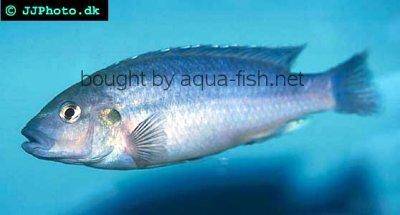Mbuna cichlid - Melanochromis lepidiadaptes
Scientific name: Melanochromis lepidiadaptes
Common name: Mbuna cichlid
Family: Cichlidae
Usual size in fish tanks: 8 - 10 cm (3.15 - 3.94 inch)
014
Recommended pH range: 7 - 8.3
Recommended water hardness: 10 - 23°N (178.57 - 410.71ppm)
0°C 32°F30°C 86°F
Recommended temperature range: 22 - 26 °C (71.6 - 78.8°F)
The way how these fish reproduce: Spawning
Where the species comes from: Africa
Temperament to its own species: peaceful
Temperament toward other fish species: aggressive to smaller
Usual place in the tank: Middle levels
Origin
Africa; Mbuna cichlid is endemic to Lake Malawi.
Lifespan
The expected life span for Melanochromis lepidiadaptes is 8-10 years.
Short description
Melanochromis lepidiadaptes are very active fish that need to be kept with other species that are also active. They can be aggressive to their own kind; this can be reduced by keeping one male with 2-3 females.
Although these are not the most aggressive Mbuna species they should still be housed with species of a similar size but try to make sure that their tank mates have a different colouration or they could become aggressive to these as well.
They will require lots of rock in the aquarium and make sure that it is stacked so that lots of nooks and crannies are formed to provide plenty of hiding places for harassed females or subdominant males to escape.
Like all of the larger cichlids, they are high waste producers so make sure that the filtration system can cope with this and make sure that regular water changes are performed on a weekly basis to keep the quality high.
Food and feeding
Mbuna cichlid will accept quality flakes or cichlid pellets as well as vegetable matter. The occasional treat of brine shrimp will also be readily accepted. Add peas or romaine lettuce, spinach and spirulina flake to vary the diet.
Sexing
Males display a silvery blue colouration; the females will have a duller brown colouration.
Breeding
The female will mouth brood the eggs and fry for about 3 weeks, during this time she may hide away and refuse to eat. When the fry have been released, they should be given Infusoria or an algal based food as meaty foods can cause problems early on in their lives.
It is easy to spot a female that is carrying as her mouth will look irregular as she distend her jaws to accommodate the fry, she can become stressed easily during this time and spit the young too early so make sure that she can hide away when she needs to.
When she feels ready the fry will be released where they can easily consume Infusoria or newly hatched brine shrimp but at any sign of danger for the first few days she will scoop the young back into her mouth for protection.
Picture
Bought by aqua-fish.net from jjphoto.dk.


 Thread-finned
Thread-finned  Acara
Acara  Yellow
Yellow  Patrick's
Patrick's  Blue
Blue  Green
Green  Acara
Acara  White
White  Compressed
Compressed  Pastel
Pastel  Midas
Midas  Red
Red  Bluemouth
Bluemouth  False
False  African
African  Agassiz's
Agassiz's  Banded
Banded  Yellow
Yellow  Cockatoo
Cockatoo  Blue
Blue  Blackstripe
Blackstripe  Highfin
Highfin  Redstripe
Redstripe  Threadfinned
Threadfinned  Macmaster’s
Macmaster’s  Panda
Panda  Norbert’s
Norbert’s  Blue
Blue  Thin-line
Thin-line  Three-striped
Three-striped  Viejita
Viejita  Flier
Flier  Archocentrus
Archocentrus  Convict
Convict  Seven
Seven  Spiny
Spiny  Oscar
Oscar  Sunshine
Sunshine  Chitande
Chitande  Firebird
Firebird  Midnight
Midnight  Lake
Lake  Sunshine
Sunshine  Aulonocara
Aulonocara  Nyasa
Nyasa  Ruby
Ruby  Grants
Grants  Aulonocranus
Aulonocranus  Chameleon
Chameleon  Benitochromis
Benitochromis  Orinoco
Orinoco  Yellow
Yellow  Brichard’s
Brichard’s  Guenther’s
Guenther’s  Southern
Southern  Cichla
Cichla  Peacock
Peacock  Chiseltooth
Chiseltooth  Bolivian
Bolivian  Red
Red  Many-pointed
Many-pointed  Jack
Jack  Red
Red  Three
Three  Keyhole
Keyhole  Azureus
Azureus  Red
Red  Jackson’s
Jackson’s  Crenicichla
Crenicichla  Honduran
Honduran  Blue-eye
Blue-eye  Afra
Afra  Frontosa
Frontosa  Slender
Slender  Malawi
Malawi  Chequerboard
Chequerboard  Checkerboard
Checkerboard  Malawi
Malawi  Ectodus
Ectodus  Tanganyika
Tanganyika  Canara
Canara  Green
Green  Rostratus
Rostratus  Pearl
Pearl  Geophagus
Geophagus  Yellowhump
Yellowhump  Suriname
Suriname  Redhump
Redhump  Red
Red  Dority’s
Dority’s  Argentine
Argentine  Burton’s
Burton’s  Victoria
Victoria  Haplochromis
Haplochromis  Jewel
Jewel  Banded
Banded  Lifalili
Lifalili  Lowland
Lowland  Texas
Texas  Pantano
Pantano  Severum
Severum  Banded
Banded  Severum
Severum  Rainbow
Rainbow  Parrot
Parrot  Chocolate
Chocolate  Brown
Brown  Marlieri
Marlieri  Golden
Golden  Striped
Striped  Masked
Masked  Konye
Konye  Blue
Blue  Trewavas
Trewavas  Electric
Electric  Dwarf
Dwarf  Redbreast
Redbreast  Lamprologus
Lamprologus  Gold
Gold  Greenface
Greenface  Mayan
Mayan  Aurora
Aurora  Blue
Blue  William’s
William’s  Zebra
Zebra  Malawi
Malawi  Blue
Blue  Blue
Blue  Parallel
Parallel  Purple
Purple  Flag
Flag  Bolivian
Bolivian  Ram
Ram  Basket
Basket  Haitian
Haitian  Zebra
Zebra  Striped
Striped  Neolamprologus
Neolamprologus  Brevis
Brevis  Fairy
Fairy  Neolamprologus
Neolamprologus  Cylindricus
Cylindricus  Hecq’s
Hecq’s  Neolamprologus
Neolamprologus  Lemon
Lemon  Mustax
Mustax  Daffodil
Daffodil  Six-bar
Six-bar  Five-bar
Five-bar  Marbled
Marbled  Giraffe
Giraffe  Blue
Blue  Sulphurhead
Sulphurhead  Wolf
Wolf  Jaguar
Jaguar  Blue
Blue  Marakeli
Marakeli  Madagascar
Madagascar  Pinstripe
Pinstripe  Pelmatochromis
Pelmatochromis  Kribensis
Kribensis  Striped
Striped  Red
Red  Deepwater
Deepwater  Fenestratus
Fenestratus  Nichols’
Nichols’  Southern
Southern  Bumble
Bumble  Demason’s
Demason’s  Slender
Slender  Red
Red  Mbuna
Mbuna  Malawi
Malawi  Kenyi
Kenyi  Powder
Powder  Altum
Altum  Angelfish
Angelfish  Angelfish
Angelfish  East
East  Juba
Juba  Earth
Earth  Electric
Electric  Azure
Azure  Lionhead
Lionhead  Discus
Discus  Blue
Blue  Red
Red  Zebra
Zebra  Brichard’s
Brichard’s  Blue
Blue  Firemouth
Firemouth  Zebra
Zebra  Yellow
Yellow  Blue
Blue  Dwarf
Dwarf  Blunthead
Blunthead  The
The  White
White  Twoband
Twoband  Fenestratus
Fenestratus  Window
Window  Tailbar
Tailbar  Black
Black  Redhead
Redhead  Oaxaca
Oaxaca  Xenotilapia
Xenotilapia